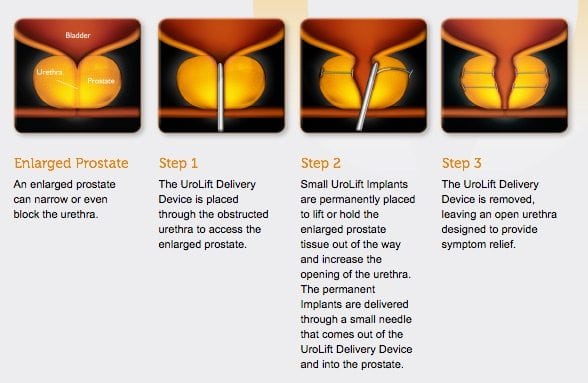Middle-aged men usually don’t have the name for it, but they know the drill. It’s frequent urination (at least once or twice a night, interrupting sleep), a sensation of incomplete emptying of the bladder, a stream that starts and stops, difficulty starting urination, residual dribbling of urine and returning to urinate almost immediately after finishing.
Sound familiar? These symptoms describe the effects of an enlarged prostate, often called benign prostate hyperplasia. It is, by far, the most common prostate issue for men over 50. About half of men age 51 to 60, in fact, have an enlarged prostate. Fortunately, it’s noncancerous. Medications can help, though some patients report dizziness and fatigue. Traditional procedures that remedy urination problems sometimes cause undesired sexual-function side effects. A new technique called UroLift, however, has shown no such effects while making middle-aged men satisfied in a way the Health News Hub simply cannot convey as vividly as a headline writer at the Daily Mail, a British tabloid: “‘Going to the loo seemed to take hours’: Bob describes being transformed by newly-approved operation that can help men turn their taps back on.”

Of course. So what’s to like? UroLift is a minimally invasive procedure, often performed under local anesthetic, that typically does not require an overnight stay in the hospital. The prostate, a chestnut-size gland at the neck of the bladder, often swells as men age and, in extreme cases, exerts pressure on the urethra — the tube that transports urine from the body. The UroLift technology, approved by the Food and Drug Administration in 2013, allows a surgeon to open the urethra with tiny implants that hold back the enlarged tissue, the manufacturer says, “like tiebacks on a window curtain.” With no cutting or heating, it’s the first BPH treatment that does not remove prostate tissue or affect sexual function.
Virtually all patients go home the same day, without a catheter, and many become symptom-free (as in a return to normal urination) in as little as two weeks. Some patients experience urinary discomfort during recovery, up to a month. Recovery for UroLift patients, in two- and four-year studies funded by the manufacturer, was faster than recovery from traditional transurethral resection (TURP) surgery that trims excess prostate tissue. Perhaps because of its newness and the difficult placing the implants precisely, about 14 percent of the first 140 UroLift patients needed a second procedure within four years to relieve symptoms.
For more information on the Tallwood Urology & Kidney Institute, click here.

